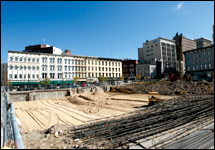Thriving Communities / News & Views / Articles from 1995 to 2012 / Sleepless in Michigan, but not in Seattle
Sleepless in Michigan, but not in Seattle
A West Coast highway’s fate has lessons for the Motor City and the Auto State
October 27, 2006 | By Keith Schneider
Great Lakes Bulletin News Service
 | |
| Keith Schneider/MLUI | |
In Seattle, buses and bikes are helping to keep auto traffic down. |
SEATTLE—It may not seem like a big deal in Michigan that the fate of an old elevated highway running along this city’s waterfront puts two former Michiganders at odds. Or that settling their dispute will decide what Seattle looks like for the next century. But, in fact, the disagreement offers lessons for those of us still living in the Wolverine State.
Cary Moon, an engineer, planner, landscape architect, and prominent community activist here wants to tear down the earthquake-damaged Alaskan Way Viaduct, replace it with a bayside boulevard and park, and turn Seattle’s noisiest district into a waterside landscape fit for strolling, picnics, and people-watching.
John Rahaim, an architect and planner in Seattle’s Department of Planning and Development, wants to do that, too. But he also supports an extraordinarily expensive additional step: burying the viaduct’s six lanes of traffic in a huge tunnel, below the boulevard and park.
The dispute abounds in ironies, especially in this gubernatorial election year.
It’s hard not to envision Ms. Moon’s and Mr. Rahaim’s previous lives in Michigan when one of Republican candidate Dick DeVos’ commercials comes on the TV in their old home state. Since February, Mr. DeVos’ ads often show sad, unemployed couples throwing their downcast kids’ bikes onto the last available space in their U-hauls and heading for the state line.
But it is just as hard to avoid seeing anything in Mr. DeVos’s spots, or, for that matter, Michigan Governor Jennifer Granholm’s own commercials, that suggest solutions to the state’s overbearing economic problems that might bring Ms. Moon or Mr. Rahaim back home.
Those missing solutions are the same steps, wouldn’t you know, that Seattle used to get them to move to the Pacific Northwest in the first place: more transit, parks, housing close to jobs, investment in genuine neighborhood vitality—and much, much more regional cooperation. Despite their viaduct differences, these expatriate Michiganders agree that Seattle has, in spades, the ingredients crucial to building 21st-century American economies.
Better Ideas
 | |
| MLUI | |
| While Michigan thinks about building ever wider highways, Seattlites discuss getting rid of the one atop the Alaskan Way Viaduct that effectively walls off their waterfront. |
in Michigan.”
Mr. Rahaim, a Southfield native with a U of M architecture degree and a University of Wisconsin graduate degree in planning and urban design, said he gave up on building his career in Detroit’s Cass Corridor because, “Michigan doesn’t care about cities.”
Indeed, Seattle’s intense viaduct controversy is the kind of conversation that Michigan has never really had. In an era of urban highway teardowns—San Francisco, Milwaukee, Portland, Boston, and New York have all done it with great economic rewards—Michigan’s Legislature and Detroit, its largest metropolitan region, are still anxious to keep building bigger roads.
| A VIADUCTT FOR WAIKIKI? | |
 |  |
| Proponents of tearing down Seattle‘s viaduct use this “before and after” shot to help residents visualize what the three-story structure is doing to their downtown by showing the harm it would do if it was in Waikiki. | |
In Seattle, that idea seems a thing of the past. Ms. Moon and Mr. Rahaim’s principal argument is over whether the highway, which currently handles one-fifth of the region’s north-south traffic, is really needed any more. And one reason Ms. Moon’s idea is attracting support from a growing coalition of citizens is that it is vastly cheaper than Mr. Rahaim’s idea.
And here is another irony: Seattle and Washington State may forego a highway even though they can actually afford to build it, thanks to the cresting of a robust knowledge- and trade-driven economy that has surged here partly because Seattle and Washington State plan and build regionally.
Many Washington residents here, uninterested in more and bigger roads, prefer using their taxes to develop truly innovative responses to the population growth that is reshaping the nation’s 13th-largest metropolitan region and 14th-largest state. Seattle, for instance, may eliminate thousands of on-street, downtown parking spaces to allow for more busses, bikes, and new streetcars. If the city can coax commuters out of their cars, it could then build more homes and businesses instead of expensive parking decks.
Such discussions are only rarely heard in Michigan. Southeast Michigan’s leaders believe that road construction is the secret to economic well-being. But it’s not, particularly in Southeast Michigan, where neither the region nor the state has money for major new road construction projects. As for regional cooperation, the city-suburb, rich-poor, black-white barriers are higher in metro Detroit than any place in the nation.
The state sorely needs an authentic path to prosperity. It can borrow ideas from Seattle. But it doesn’t need to go that far. Right here in Michigan three regions—Grand Rapids, Ann Arbor, and Traverse City—are embracing a Seattle-like development strategies that also take regional cooperation more seriously.
New Century, New Needs
 | |
| Keith Schmeider/MLUI | |
| Former Detroiter John Rahaim left his hometown because, he says, “Michigan doesn’t care about cities.” As a Seattle planner, he wants to bury the Alaskan Way Viaduct’s traffic in a tunnel under an urban, oceanside park. |
I’m old enough to remember the deteriorated streets, empty spaces, and lurking dangers that each of these places used to have. I’m not too old to marvel at the clean, green, exciting, job-rich, entrepreneurial communities they’ve become. It may seem strange to Michiganders, but most big American cities are turning into great places to live and work. Three fifths of the jobs in the majority of metropolitan regions are tied to their central cities, according to the U.S. Department of Housing and Urban Development. Seattle, for instance, anticipates generating 69,000 new jobs downtown by 2020.
Cities are rebounding largely without the help of Washington D.C. and state capitals, which are now distant coliseums of gladiatorial, partisan combat. Fortunately, the American system is still flexible enough to enable good public interest ideas to settle in place where they can best flourish—metropolitan regions, which are right-sized for the era.
 | |
| Keith Schneider/MLUI | |
| Rapid transit systems usually spur new trackside development. |
It is also an urgent question. Michigan lost some 200,000 young people to the new economies of Seattle, or Denver, or Phoenix, Charlotte, and other regions in the 1990s, and that out-migration is getting worse. From 2000 to 2005, according to the U.S. Census Bureau, 165,000 more people
left Michigan.
At last, this inexorable exodus is seen as a problem that must be solved. But the solutions proposed in this fall’s gubernatorial campaign are outdated. Mr. DeVos tirelessly insists the answer is in reducing Michigan’s business taxes and regulations. His critics respond that, with this G.O.P. economic orthodoxy now in place in Michigan for 15 years, it should be working by now.
On the other hand, Ms. Granholm, the Democratic incumbent, was once quite interested in Smart Growth. She won in 2002 on a platform to curb sprawl, promote transit, and fix highways instead of building new ones. She called for investing in downtowns, protecting the environment, conserving farmland and open space, and ensuring neighborhood redevelopment. Her proposals, which aimed to reduce the state’s reliance on the auto industry, mirrored the development options that are proving so successful in Seattle, Portland, Chicago, and dozens more metropolitan regions.
But after appointing a bi-partisan, blue ribbon, statewide, 26-member commission in 2003 to recommend ways to implement these ideas, and signing into law several council recommendations, the governor no longer touts her quality of life development agenda.
 | |
| Keith Schneider/MLUI | |
| Rapid regional transit makes Portland, seattle, and dozens of other cities more vital. |
indicate was slightly ahead when this article
went to press, is now promoting renewable fuels, new inventions to ensure homeland security, overseas corporate recruiting, and stern law enforcement that protects children.
Busting out of the Box
It’s not that Mr. DeVos, Ms. Granholm, and the state’s other senior officials and policy experts are unaware of these new, more effective approaches to development. A study published in June by Michigan Future Inc., an Ann Arbor-based think tank, recommended three by-now very familiar steps to sustainable development:
- Invest more in the state’s university system to train knowledge workers.
- Make cities more attractive to those workers by investing in public transportation, cyber-communications, housing that is affordable, and environmental protection.
- Encourage civic, government, and business leaders to form regional alliances that decide and act cooperatively on local success strategies.
“Michigan needs to switch to a discussion about how we do well in the economy of the future, rather than what we can do to save the past, or even worse, who is to blame for the old economy,” said Lou Glazer, the group’s president and the study’s author.
Perhaps Ms. Granholm or Mr. DeVos could stop arguing over who’s responsible for the state’s high unemployment and declining housing values, and instead learn from the development strategies of Michigan’s three most successful regions.
Grand Rapids, the state’s Smart Growth leader, used its water and sewer infrastructure in the 1990s to set growth boundaries and contain sprawl. Mr. DeVos’ hometown, which may be as tax-averse as he, invested $2 billion in tax and private dollars in downtown redevelopment. Twice since 2000, metropolitan voters approved property tax increases to finance transit improvements. The city’s population grew in the 1990s as new housing, arts, and entertainment centers rose and major streets received serious facelifts.
 | |
| Mark Eskenazi | |
| Former Michigander Cary Moon leads opposition to the viaduct and traffic tunnel, asserting that better transit service can replace the highway’s capacity. |
Ann Arbor is embracing regionalism, too. Two years ago, voters increased their property taxes to finance permanent protection of farmland and open space via a surrounding greenbelt. It is increasing the number of homes and apartments allowed in its downtown, improving public transit, and advocating for a new, rapid, regional line to Detroit.
In two of these cities new non-governmental and governmental forums emerged. In Grand Rapids, the Grand Valley Metro Council, an association of local governments, showed officials how to plan as a region, while the United Growth coalition, started by Michigan State University, drew neighborhood groups and interest groups in rural townships together. It then helped Kent County start one of the most successful farmland preservation programs in the Midwest.
 | |
| Bruce Giffin | |
| Regional partnerships add to the success of Grand rapids‘ downtown redevelopment. |
These cities—along with Ann Arbor and its strong push for farmland protection and increased urban development—are achieving economic breakthroughs through their cooperative, regional pursuit of more public transit, more parks and open space, better housing and neighborhoods, and energy efficiency.
Seattle’s Sucess Secrets
Whether Michigan can make the U-turn that will actually coax more U-hauls to start heading back its way remains to be seen. But the fact that so many other states have done so offers encouragement. Seattle’s contentious viaduct discussion may contain a clue.
When it opened in 1953, the 2.2 mile-long Alaskan Way Viaduct represented a top national economic tool: providing motorists fast roads from central cities to growing suburbs. Similar shoreline freeways arose in New York, Boston, San Francisco, Portland, Milwaukee, Washington, Cleveland, and dozens more cities.
But early in this century, Seattle began understanding that its foreboding, three-story, dark gray viaduct separated residents from one of the new foundations of metropolitan prosperity: Easy access
to natural resources, especially a spec-tacular shoreline.
Then, in February 2001, a 6.8 Richter-scale earthquake severely damaged the viaduct. Engineers said, for safety’s sake, it needed to be replaced. Since then, the grinding debate about viaducts, tunnels, boulevards, parks, and shorelines has reflected tectonic shifts in how American cities are choosing to invest infrastructure dollars to enhance economic competitiveness.
“Imagine our waterfront without the noise, blight, and dirt from a nearby elevated freeway,” wrote Greg Nickels, Seattle’s two-term Democratic mayor, in an article late last year. “Imagine walking along the waterfront and actually hearing the words of the person next to you, or hearing the cry of a seagull and the splash of the waves instead of rush hour.”
Essentially, Seattle is considering three options.
The state and its Democratic speaker of the house want a new, much bigger, elevated highway, costing $3.3 billion. Mayor Nickels, the city council, his planning staff (including Mr. Rahaim) and the city’s most influential business and neighborhood groups want the tunnel, boulevard, and waterfront park, costing $5.5 billion. Ms. Moon and the People’s Waterfront Coalition want to forget the viaduct and tunnel, take other steps to ease traffic, and build the park and boulevard, costing less than $1 billion.
 | |
| Gary Howe | |
| Traverse City is welcoming riverside development, improving transit, and participating in a regional transportation and land use study. |
If Seattle finally adopts Ms. Moon’s idea, it would be in plenty of good, Midwestern company. Cleveland is replacing the western section of the six-lane Memorial Shoreway, along Lake Erie, with a boulevard. Milwaukee spent $45 million to tear down the East Park Thruway in 2003, restore the street grid beneath it, and free up nearly 20 acres of land that has become one of the city’s hottest real estate development markets.
“The hardest part was convincing people that the highway wasn’t needed,” recalled John Norquist, Milwaukee’s former mayor and now president of the Chicago-based Congress for the New Urbanism, a national non-profit design and planning group. “What happens is that traffic, for the most part, redistributes. Drivers have brains. They find other ways
to get around.”
Ms. Moon noted that, regardless of what is built, there will be three or four years when the waterfront has no highway at all. Seattle’s plan for coping calls for new transit service, improved streets, new street signals, and systematic encouragement of other alternatives. In fact, she said, the city’s temporary plan is similar to the one her group proposes for a
permanent solution.
“We’re going to find out that’s all we really need,” she predicted.
Keith Schneider is the Michigan Land Use Institute’s editor and director of program development. Reach him at keith@mlui.org





